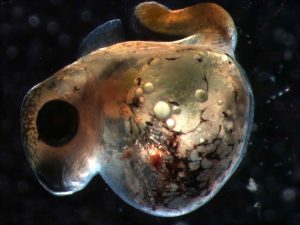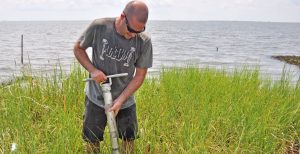Study Links Negative Biological Impacts to Oil-Exposed Killifish
– June 4, 2013
Scientists from Louisiana State University, University of California-Davis, and Clemson University, studying Deepwater Horizon impacts on killifish from oiled Louisiana estuaries, found that adult fish exhibited genetic responses that indicate physical and reproductive impairment over one year post spill.
Laboratory tests on killifish embryos exposed to oiled sediments showed developmental defects.
These results were published in an article titled, Multi-tissue molecular, genomic, and developmental effects of the Deepwater Horizon oil spill on resident Gulf killifish (Fundulus grandis) in the April 2013 edition of Environmental Science & Technology.
Researchers collected killifish – a non-migratory, estuarine-dependent prey species – between May 2010 and August 2011 from oiled areas in Louisiana and from non-oiled areas in coastal Mississippi and Alabama. This time period coincided with peak killifish spawning. They also collected sediment from oiled and non-oiled sites in Louisiana in between 2010 and 2011.
The team measured a contaminant-specific protein, CYP1A, in killifish and found highly elevated levels in gill, liver, intestine, and kidney of field-collected adults and in larval fish exposed to sediments from oiled sites. They purposely tested these tissues for “insights into the route of exposure based on the differential expression between organs and their functional roles.” Elevated CYP1A protein in the gill can indicate exposure to oil-derived PAHs via water, the intestine can indicate exposure through diet, and the kidney and liver suggests systemic circulation of PAHs. Results showed that “killifish were exposed to the toxic components of oil, and that the gill was a sensitive target of such exposure.” In comparing gene responses between gill and liver tissue, there was a “more dramatic response in the gill” which “may be reflective of this organ’s direct contact with the contaminated external environment.”
Researchers exposed killifish embryos (derived from un-exposed adults) to previously-collected contaminated sediment samples for 21 days to test for sensitive early-life stage effects.
Many of these embryos did not hatch and those that did “were significantly smaller,” had “pronounced bradycardia” (slow heart rate), and exhibited “poor vigor at hatch.”
Researchers concluded that evidence of exposure to PAHs in adult fish was “coincident with the arrival of contaminating oil” and that embryos exposed to contaminated sediment resulted in “developmental abnormalities.” They also concluded that “biological responses appear to be more sensitive indicators of contamination.” In their discussions, the team suggests that “these data are predictive of population-level impacts in fish exposed to sediments from oiled locations along the Gulf of Mexico coast,” and that these analyses “will provide for measures of acclimation or potential recovery in oil-exposed fish populations.”
Study authors are Benjamin Dubansky, Andrew Whitehead, Jeffrey Miller, Charles D. Rice, and Fernando Galvez (Environmental Science & Technology 2013, 47 (10), pp 5074–5082).
###############
This research was made possible in part by grants from BP/The Gulf of Mexico Research Initiative (GoMRI) through Louisiana State University. Other funding sources included the National Science Foundation (DEB-1048206 and DEB-1120512 to A.W.) and the National Institutes of Health (R15-ES016905−01 to C.D.R.).
The GoMRI is a 10-year independent research program established to study the effect, and the potential associated impact, of hydrocarbon releases on the environment and public health, as well as to develop improved spill mitigation, oil detection, characterization and remediation technologies. An independent and academic 20-member Research Board makes the funding and research direction decisions to ensure the intellectual quality, effectiveness and academic independence of the GoMRI research. All research data, findings and publications will be made publicly available. The program was established through a $500 million financial commitment from BP. For more information, visit https://gulfresearchinitiative.org/.
© Copyright 2010- 2017 Gulf of Mexico Research Initiative (GoMRI) – All Rights Reserved. Redistribution is encouraged with acknowledgement to the Gulf of Mexico Research Initiative (GoMRI). Please credit images and/or videos as done in each article. Questions? Contact web-content editor Nilde “Maggie” Dannreuther, Northern Gulf Institute, Mississippi State University (maggied@ngi.msstate.edu).







